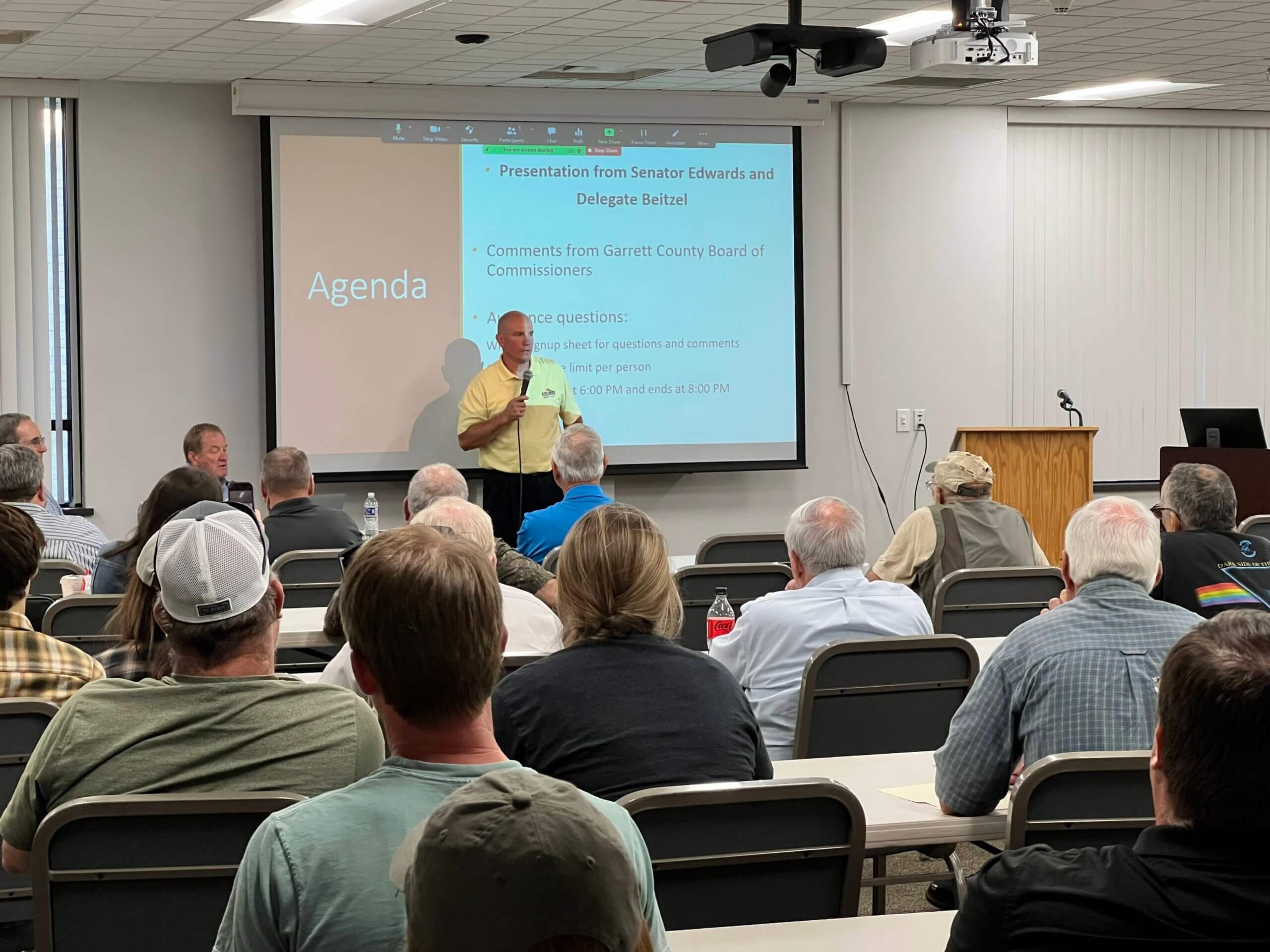On Monday, August 8, at 6 pm, Delegate Wendell Beitzel and Senator George Edwards held a session to review how funding was allocated for a new trail through protected portions of the Youghiogheny River.
1968: General Assembly passes the Scenic and Wild Rivers Act.
- Act “mandated the preservation and protection of natural values associated with rivers designed as Scenic and/or Wild.”
- A Scenic River is a “free-flowing river whose shoreline and related land are predominantly forested, agricultural, grassland, marshland, or swampland with a minimum of development for at least 2 miles of the river length” [Natural Resources Article, 8-402(d)(2)].
- A Wild River is a “free-flowing river whose shoreline and related land are underdeveloped, inaccessible except trail, or predominantly primitive in a natural state for at least 4 miles of the river length” [Natural Resources Article, 8-402(d)(3)].
- Youghiogheny is eventually named a Scenic River. The section between Millers Run and the southern corporate limits of Friendsville is designated as Scenic & Wild.
The Youghiogheny
1996 the Youghiogheny Scenic and Wild River Local Advisory Board developed the Youghiogheny Maryland Scenic and Wild Rivers Plan.
Recommendation for Trail:
- The State should consider the possibility of a trail system for public access as well as emergencies.
- The public trail system should be developed on state lands in such a way as to preserve the wild and scenic character of the River.
- ATV use in the Scenic Corridor should be prohibited on state land, except for emergencies.
The Youghiogheny River Resource Management Plan created Goals and Recommendations.
- Goal 8 in the Plan is to provide continued public use and enjoyment of a full range of recreational activities.
- Goal 8 Objectives:
- Allow public access on state lands.
- Encourage users of private property to seek written permission for recreation.
- Educate the river users and enforce water safety regulations to maximize safety and enjoyment.
- Realize the economic benefits of tourism while preserving the attractiveness of the natural features which are essentially this activity.
Timeline
- 2014: Senator Edwards and Delegate Beltzel send letter to DNR Secretary inquiring about the possibility of trail along the Youghiogheny River Corridor to create a segment as part of the Eastern Continental Divide Loop Trail.
- June 12, 2014: Letter from Secretary Gill responding that he is unable to support the Garrett Trail proposal with stated reasons.
- We continued to support GarrettTrails efforts to develop the trail over time but could not get necessary funding due to budget constraints.
- COVID-19 pandemic started in 2020. There were shutdown and masking mandates. The 2020 session was cut short. At the end of the 2021 session, it appeared that there would be a $2.4 billion structural deficit for the 2022 session.
- During the pandemic, Maryland faired well; Maryland’s economy did not experience serious decline and federal stimulus funding provided a large amount of revenue that resulted large surplus going into the 2022 Session.
- Businesses were being tired of being locked up and expressed a desire to get outdoors. The State owns about 25% of Garrett County. Deep Creek and Garrett County weathered the pandemic in good financial health.
- September 27, 2021: Delegate Beitzel sends message to Garrett Trails asking about the status of a Youghiogheny Trail plan.
- October 19: Senator Edwards and Delegate Beitzel meet with Garrett Trails, who present ideas for a trail system along the Youghiogheny River as part of their Eastern Continental Divide Loop project.
- October 29: Senator Edwards and Delegate Beitzel have a follow-up meeting with the Garret Trails about the proposal and are also joined by Daryl Anthony, executive director of DNR’s Office of Outdoor Recreation.
- December 8: Garrett Trails sends Delegate Beitzel an Estimate on Probable Costs for the “Yough Canyon Trail” project. Across 4 sections, the total estimate is about $3.3 million.
- December 20: Senator Edwards, Delegate Beitzel, Garrett Trails, and Director Anthony meet once more to review the estimates on Probable Costs. They discussed several options for the project and requested a revised estimate of Probable Costs.
- January 12, 2022: The 2022 Maryland General Assembly legislative session begins. Legislative leaders introduce the Great Maryland Outdoors Act, SB 541 and HB 727 indicating interest in investing in outdoors recreation and trails projects.
- January 26: Garrett Trails sends Delegate Beitzel and Director Anthony a revised Opinion of Probable Costs. Now consolidated into 4 sections, the total estimate is $8.25 million.
- Alongside this revised estimate, Garrett Trails sends a map with short section descriptions, pictures, and a map of section locations.
- February-March: Delegate Beitzel consulted with legislative leaders about the project. Advised that $8.25 million is too much to ask for and would not be approved. They prioritize sections 2 and 3 from Swallow Falls to Kendell Trail, and request legislative leaders include $700,000 for section 2 and $4 million for section 3 as part of the Capital Budget.
Capital Budget Funding (HB 271)
- March: Legislative leaders continue to discuss the budget requests with Senator Edwards and Delegate Beitzel.
- During this time, legislative leaders confer with Department of Legislative Services legal counsel about the project, who advise that the project would not violate the Scenic and Wild Rivers Act.
- April 7: SB 291, the Capital Budget bill passes the General Assembly. Signed several weeks later by Governor Hogan, it includes $4 million for section 3 and a pre-authorization for $700,000 for section 2 in the FY 2024 Capital budget.
That’s how we got the funding!
June 1, 2022 Email from Secretary Haddaway-Riccio to Andre Gray, DLS
During the 2022 legislative session, $4.7 million was set aside by the Maryland General Assembly in Maryland Department of Natural Resources (DNR) Critical Maintenance Program for two trails at Sang Run State Park through the Youghiogheny River corridor: one from Swallow Falls to Kendell Trail and another from Swallow Falls to Sang Run. As you know, this appropriation was not part of DNR’s capital budget request nor the governor’s FY23 budget submission.
Trail development of this scope and size will require a diligent and thoughtful planning process. This is particularly true given that the locations specified in the legislative language must take into consideration the regulatory provisions of the Scenic and Wild Rivers Act. The provisions of the law, along with terrain challenges, may result in the need to adjust the location of the trails and develop design features that would work in this corridor. Last but not least, DNR would like to ensure that we receive adequate community and public input through the process.
Given that Critical Maintenance, funds cannot be used to support feasibility studies. I wanted to let you know that DNR will use a portion of the mandated funding for a preliminary engineering report. This will allow us to develop a draft plan that would ensure that any trail development in the corridor is fully consistent with statute and regulations governing Wild and Scenic River designations. It would also provide a draft document by which we could solicit public engagement and input, a hallmark of the Hogan administration and DNR.
Sincerely,
Jeannie
Yough Trail Funding (Andrew Gray-DLS)
Hello Chair Guzzone and Chair Barnes,
By the attached e-mail dated June 1st, Secretary Jeannie Haddaway-Riccio f the Department of Natural Resources (DNR) on show the funding for the Youghiogheny River Trail in Garrett County will be handled.
There is a $4.7 million in the fiscal 2023 capital budget bill under the Critical Maintenance Program for this purpose as the following:
Fiscal 2023 – $4.0 million in general obligation (GO) bonds for Section 3 – Sang Run to Kendell Trail; and
Fiscal 2024 – $0.7 million in GO bonds preauthorized for fiscal 2024 for Section 2 – Swallow Falls to Sang Run.
Secretary Haddaway-Riccio notes that DNR intends to use the funding noted above for a preliminary engineering report that would then provide a draft document to solicit public engagement and input. The funding would be used for a preliminary engineering report instead of a feasibility study because of restrictions on how Critical Maintenace Program funding, which is presumably also GO bond funding, may be used.
Our thoughts about the process:
- Followed by typical budget request process.
- Similar processes are followed to get funding for things like fire halls, monuments, and other state capital projects.
- Had support from key political stakeholders.
- Mayor of Friendsville, Commisioners, state representatives, local advocacy group (Garrett Trails), and General Assembly leaders all expressed approval.
- Does not violate any existing laws.
- Legal counsel advised it would not violate Scenic and Wild Rivers Act. Provides trail access, part of the definition of a wild river.




